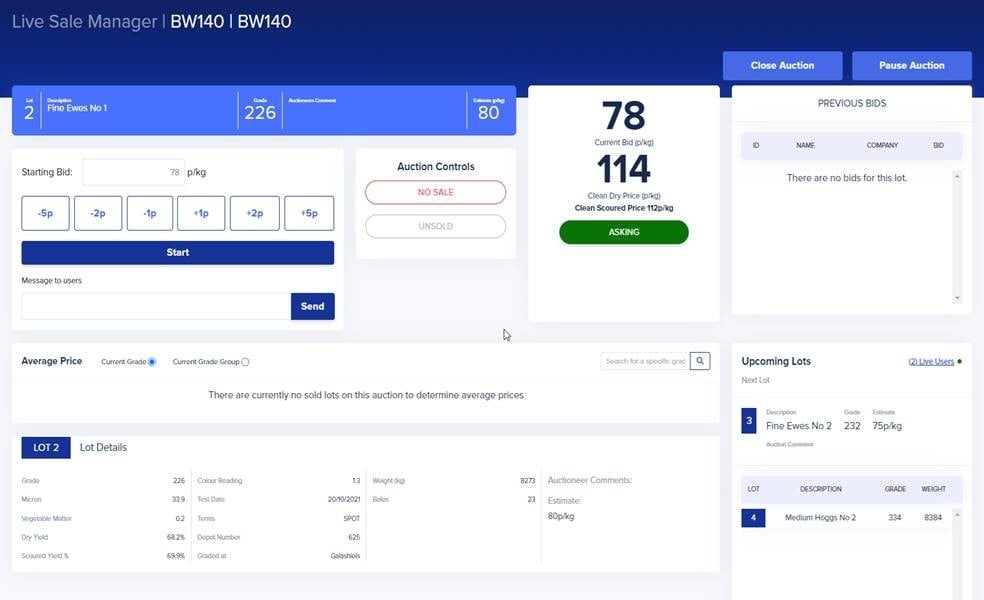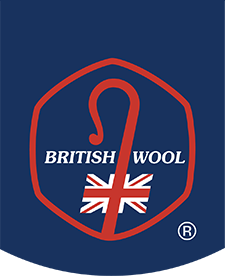British Wool auction – maximising the value of members’ wool
Selling through auction has been a tried and tested method of selling off the farm for generations, and wool is no exception.
British Wool hold 20 auctions a year with the selling season starting in July and running until June of the following year. All British wool is sold through auction as this maximises the value but also ensures members realise the true market value for their wool. By selling the wool over a 12 month period this provides a steady and consistent volume of British wool onto the market and reduces the risk of price volatility.
Historically, wool would be sold in a traditional open cry auction where sample bales of each lot would be made available for buyers to inspect. In 2003, British Wool introduced an electronic wool auction, the first country in the world to sell wool in this way. This also saw the development of wool testing rather than producing the sample bales for each lot. Roll forward to 2020 and the challenges faced by the global pandemic, British Wool once again were leaders in the global wool sector by being the first to introduce a remote online auction system. This system continues to this day which is an effective, efficient and convenient way of selling wool for both the buyers and British Wool.
We have increased the number of buyers in the auction over the last 18 months due to using an agency buyer who buys on behalf of our smaller customers. This has seen a dramatic increase in the number of different bidders per lot and the agency is now buying up to 10% of all wool auctioned.
Typically, an auction lot would be 24 bales, approx. 8 tonnes of a specific grade. Once the lot has been closed by the depot, before being allocated to sale, a core sample of wool is taken from each bale in that lot and sent for testing to the Wool Testing Authority (WTA) laboratory in North Wales.
The wool is tested for various specifications such as micron, colour, yield and vegetable matter which is vital information to buyers ensuring they can buy with confidence the type and quality of wool they need to meet their customers’ requirements.
Once the test results are received back from WTA, this information along with the grade number, grade description, weight and number of bales, is included in a sale catalogue which is sent to all British Wool registered buyers a week or so before each sale.
Sale day is normally a Tuesday with the sale’s starting at 9.30am. The auction is run by Richard Alderson, Head of Wool Sales at British Wool who explains more:
“Since Covid, the sale room is a very different place and by moving to a remote online auction system, this gives more flexibility and ensures that we as a business are continually improving which is to the benefit of all our members. Each individual lot sold at auction has a reserve price based on the test results, current economic conditions and also data from recent sales on the demand and prices achieved for that particular grade. If the bids at auction do not meet or are deemed to be below the current market value/ the reserve price, we will not sell that lot as everything we do is about maximising the value of our members’ wool.”
Richard continued: “Where a lot has not been sold due to not meeting the reserve price, the buyer with the highest bid has an opportunity at the end of the auction to negotiate with the British Wool sales team. However, at the forefront of any negotiation process is that we are here to represent our members and achieve the best possible price we can.”
Concluding Richard added: “We have seen a recovery in the market over the last 12 months which has seen improved returns to our members. We are optimistic that the improving market will continue over the current selling season resulting in better returns to our members for their 2022 wool.”
To see our latest sales report "Click Here"
 Auction Screen From Buyers View
Auction Screen From Buyers View Auction Screen From Auctioneers View
Auction Screen From Auctioneers View
